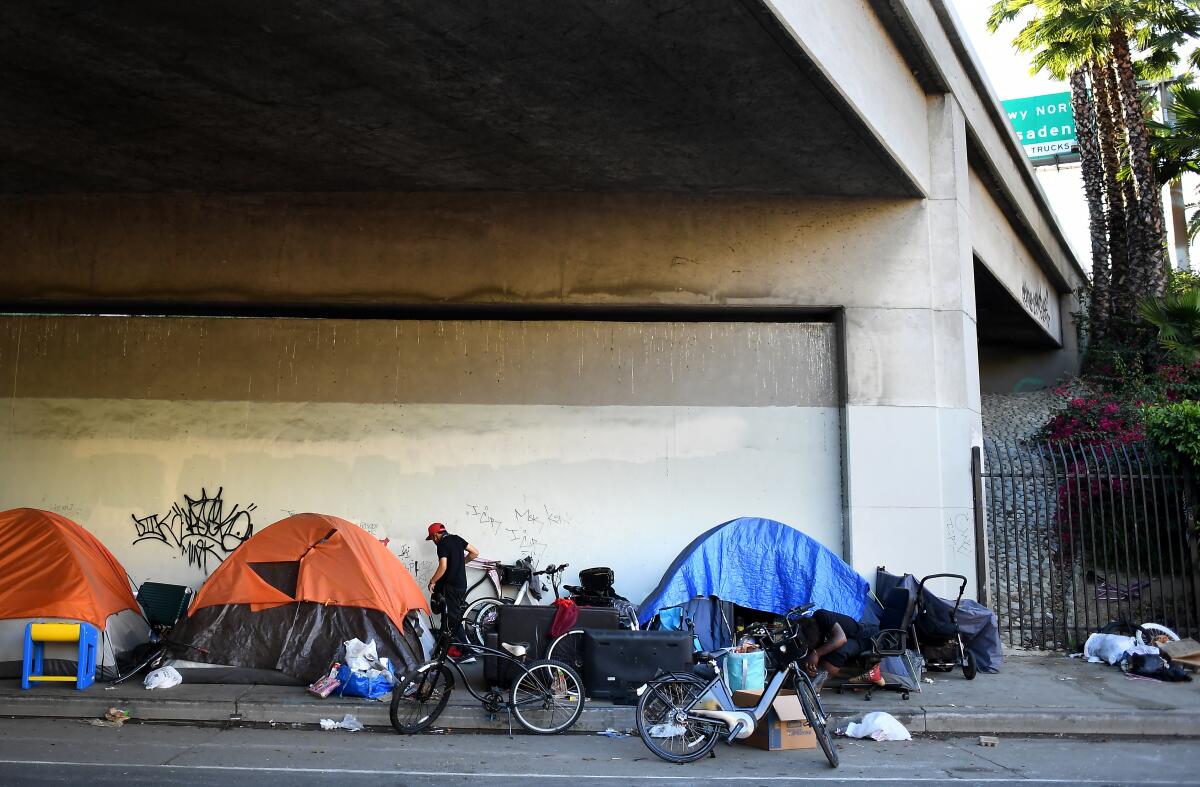L.A. city and county fight over how to shelter homeless people living near freeways

- Share via
A hearing about the moving of homeless people living near freeways was canceled Wednesday after the city and county of Los Angeles couldn’t agree on a plan for how to comply with a federal judge’s order.
Last week, U.S. District Judge David O. Carter ordered the relocation of up to 7,000 people living near overpasses, offramps and onramps, saying they face severe health risks from tailpipe emissions and car crashes. He directed the city and county to submit a plan for how to make that happen.
Talks between the two sides broke down Tuesday night after a dispute over who would pay tens of millions of dollars for the services at shelters and other sites that would house homeless people who were moved, according to court documents.
County officials proposed a “shared funding arrangement” but did not cite a specific breakdown of who would pay what. City officials said they could not agree to a plan without those specifics.
“The City would not agree to a shared funding arrangement as proposed by the County for operational costs (such as food, laundry, security, etc.) associated with City’s pilot programs,” according to a brief filed jointly by the county and homeless advocates who have intervened in the case.
In a statement Wednesday, Rob Wilcox, a spokesman with the city attorney’s office, said in a statement that the city “is not comfortable finalizing an agreement committing itself to spend hundreds of millions of dollars on the development of shelter opportunities before resolving the funding of those needed services.”
County spokeswoman Sarah Ardalani said in a statement that Los Angeles County’s budget has been hit hard by the COVID-19 crisis and that a revised budget would come in June. “It is premature to discuss funding for any specific programs at this time,” she said.
County lawyers said they would continue to try to work with the city. However, they pointed out that Los Angeles “is a major recipient of state and federal funds for homeless services, unlike other cities in the county.”
L.A. County received $1.57 billion in the first round of federal aid passed by Congress during the coronavirus outbreak while the city received $700 million. City lawyers said that “shared financial responsibility” is essential for executing their plan and that they would continue to work with the county.
Carter canceled the hearing after the two parties submitted separate plans relating to addressing the people near freeways. Both the city and county focused, with varying degrees of specificity, on measures such as constructing more shelters and creating safe parking to help people living on the streets during a pandemic.
Carter’s order to find a safer space for these people goes into effect Friday.
It came as part of an ongoing legal battle initiated by the L.A. Alliance for Human Rights, a group of downtown business owners and residents who allege that the city and county have failed to protect the public and provide adequate shelter for people living on the streets.
“They better sort this out,” Carter told The Times on Wednesday.
“Unfortunately, the city and county couldn’t agree on who was responsible for funding and operating these shelters,” Daniel Conway, policy advisor to the L.A. Alliance for Human Rights, said in a statement. “This disconnect says a lot about how Los Angeles’ homelessness crisis has reached this scale.”
In court documents, both the city and county sketched out how they planned to tackle this task amid a pandemic.
Both of their plans fall well short of laying out how to shelter all the individuals living near freeways. The Los Angeles Homeless Services Authority estimates that 6,000 to 7,000 people live near freeways throughout the county.
A federal judge has ordered L.A. to move homeless people away from freeways. Mayor Garcetti says he worries it will lead to confrontations with police.
Politicians and advocates of various stripes have voiced concern about Carter’s focus on the areas around freeways. Many say it will inevitably lead to more interactions between homeless people and law enforcement.
The city’s plan offers a timeline of 120 days to begin moving nearly 3,000 people who are currently staying in city recreation centers or are in hotels through Project Roomkey. In court documents, the city said that recreation centers will stop sheltering homeless individuals by Sept. 30 at the latest.
Sheltering these people would come from a mix of rental assistance programs, safe parking, modular shelters and the extension of hotel leases, among other programs. That is expected to cost between $75 million and $125 million over the next 120 days.
After this, the city wants 180 days to focus on the roughly 3,100 people living near the freeways using a mix of hotels, pop-up shelters and supportive housing. The city offered little detail on what it expects to build but says it would cost between $100 million and $130 million.
The county’s plan includes providing outreach and services for as many as 350 people living near freeways in unincorporated areas. Their lawyers point out that Los Angeles County “does not have jurisdiction over the hygiene, housing, or enforcement polices within other cities.”
The county also plans to set up sanctioned camping locations for homeless individuals to bed down on and a safe RV parking pilot. It lacked specifics, though, on how it would help people who are homeless near freeways.
Carter did not immediately announce a new hearing date.
More to Read
Sign up for Essential California
The most important California stories and recommendations in your inbox every morning.
You may occasionally receive promotional content from the Los Angeles Times.








